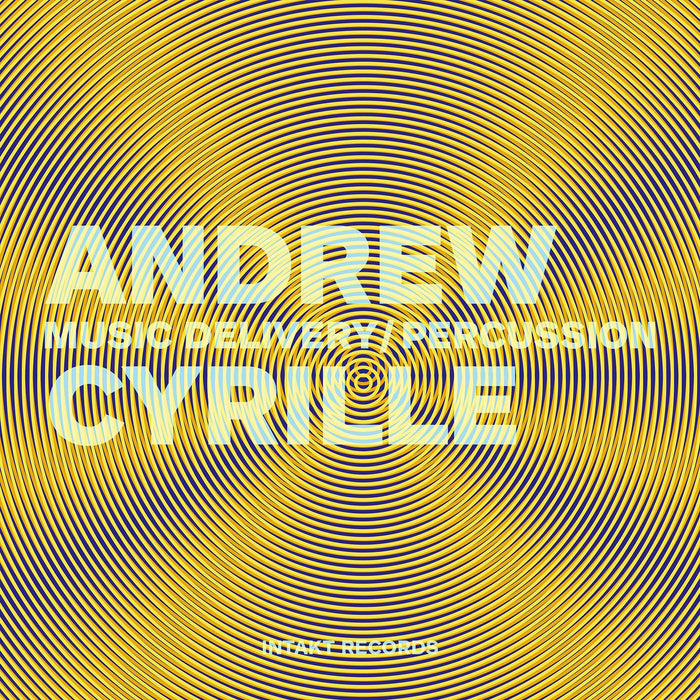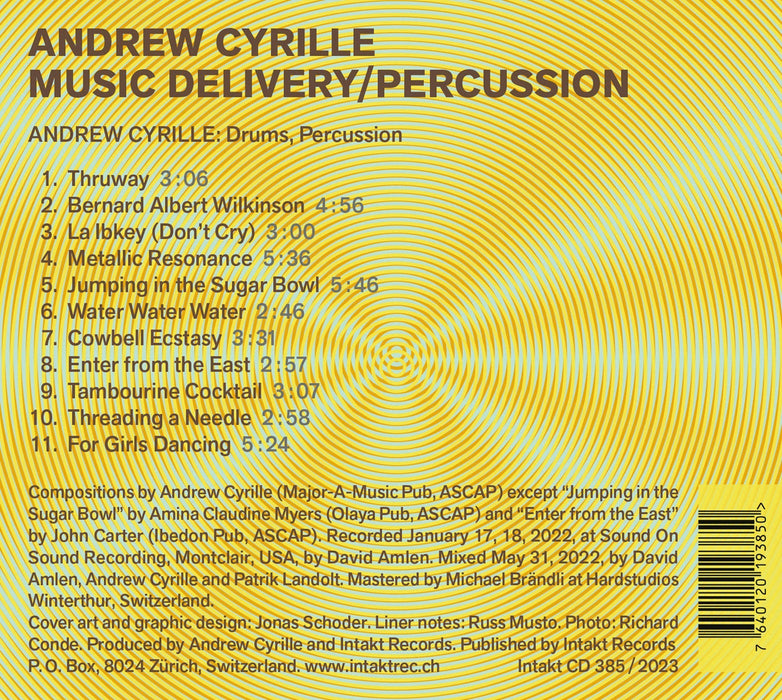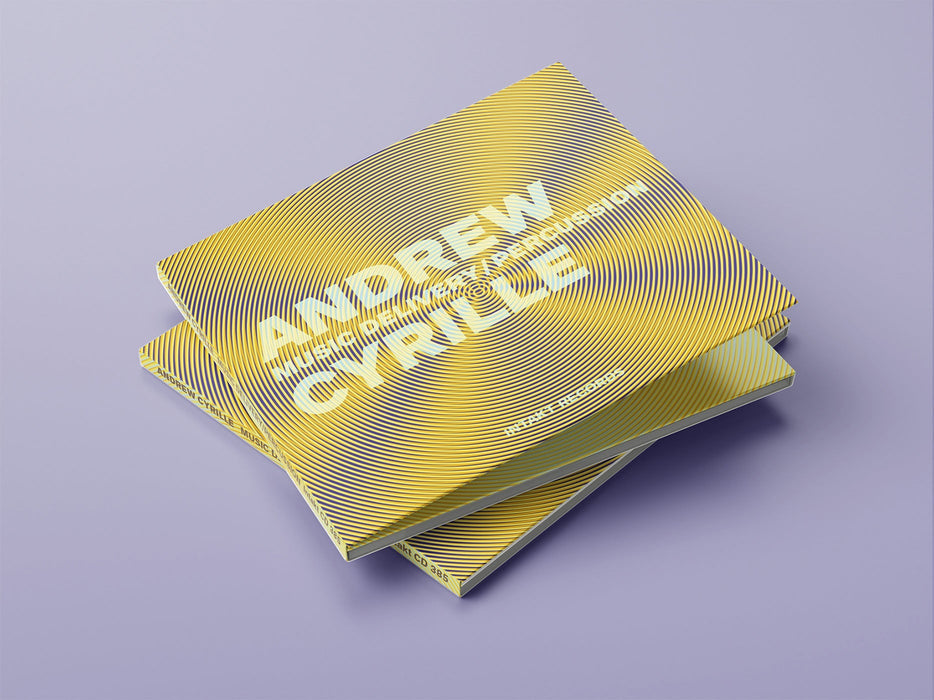


385: ANDREW CYRILLE. Music Delivery / Percussion
Intakt Recording #385/ 2023
Andrew Cyrille: Drums, Percussion
Recorded January 17, 18, 2022 at Sound On Sound Recording, Montclair, USA, by David Amlen.
More Info
Andrew Cyrille’s longtime companion Oliver Lake praises the master of African-American rhythms in his poem The Real Cyrille – “making the real magic ... the real rhythms ... the real sounds ... expanding his African/Haitian roots ... surf- ing the drums for masterful lyrical snippets ... a master of color ... painting coloring riffing always stretchin’ searchin’ lookin’ for that next sound color sound!” Lake’s words astute- ly describe the artistry of Andrew Cyrille and the music that he makes on this record. Unlike his solo albums from the 70’s and 80’s, he has broadened his approach on this remarkable solo statement. Cyrille asserts, “I wanted to have a variety percussion instruments in the compositions. So I was think- ing of melodies that could be played with tambourines, bells, cymbals, crotales, gongs, and mallets.”
Album Credits
Cover art and graphic design: Jonas Schoder
Liner notes: Russ Musto
Photo: Richard Conde
Compositions by Andrew Cyrille (Major-A-Music Pub, ASCAP) except "Jumping In The Sugar Bowl" by Amina Claudine Myers (Olaya Pub, ASCAP) and "Enter From the East" by John Carter (Ibedon Pub, ASCAP). Recorded January 17, 18, 2022 at Sound On Sound Recording, Montclair, USA, by David Amlen. Mixed May 31, 2022 by David Amlen, Andrew Cyrille and Patrik Landolt. Mastered by Michael Brändli at Hardstudios Winterthur, Switzerland.
SOLO RECORDINGS
ANDREW CYRILLE – Music Delivery/Percussion (Intakt) -
BRANDON LOPEZ –
vilevilevilevilevilevilevilevile (Relative Pitch)
DENNY ZEITLIN – Crazy Rhythm: Exploring George Gershwin (Solo Piano) (Sunnyside) -
KENNY BARRON – The Source (Artwork)
SATOKO FUJII – Torrent (Piano Solo) (Libra)
If Andrew Cyrille were a painter, he'd be Georges Seurat. If he were a poet, E. E. Cummings; a Tour de France Champion, Jacque Anqutiel; or a writer, Ian McEwan. The above masters are mentioned because Cyrille shares a command of colors, efficiency, grace, and language with his instrument equal to doyens in other disciplines. His solo outing Music Delivery / Percussion is not his first solo drums and percussion disc. He released What About? (BYG Records, 1960) and The Loop (Ictus Records, 1978). Then, there are the evergreen duo recordings with Anthony Braxton Duo Palindrome 2002. Vol. 1 & 2 (Intakt, 2004). Now in his eighties, Cyrille draws upon his associations with the legends of jazz such as Cecil Taylor, Wadada Leo Smith, David Murray, Marilyn Crispell, Muhal Richard Abrams, Oliver Lake, Reggie Workman, Jimmy Lyons. The list goes on and on.
These eleven brief compositions were recorded in 2022. Nine originals, plus "Jumping In The Sugar Bowl" by Amina Claudine Myers and "Enter From The East" by John Carter. The Myers piece performed at his drum kit swings a 4/4 pulse with sticks dancing on drumheads, metal frames, and cymbals before chanting the title. Elsewhere, Cyrille dubs hand drumming over his bass drum "La Ibkey (Don't Cry)," mines call and response rhythms on "Water Water Water," and performs on multiple cowbells on "Cowbell Ecstacy." His mallet work on Carter's "Enter From The East" is an elegant cortège, as is "Threading A Needle" featuring some delicate brushwork that sounds like a series of whispered rumors. The final track, "For Girls Dancing" harkens back to the drummer's work with dance choreographers and it is filled with subtle and sly accelerations.
https://www.allaboutjazz.com/music-delivery-percussion-andrew-cyrille-intakt-records
I first heard drummer Andrew Cyrille many years ago at the Village Vanguard as part of saxophonist David Murray's quartet. At one point, he played a solo with so much energy that, apparently, the drum kit didn't suffice. He stepped away from the drums, sticks in hand, and walked along the perimeter of the club, laying paradiddles on tabletops, empty glasses, the walls and the unoccupied seat right in front of me. Cyrille's excellent new solo project, Music Delivery/Percussion, is as evocative and inspiring as that initial encounter.
On several tracks, the drummer/percussionist uses the elemental trap kit, cymbals and sticks unit, but elemental doesn't mean elementary. "Thruway" is a polyrhythmic excursion, a kind of introduction to what follows. "Bernard Albert Wilkinson" finds Cyrille lamenting the passing of a lifelong friend. He establishes a five-beat motif, then expands on it masterfully by creating variations with different tempos and textures, and using eloquent, well-timed silences to build tension.
Setting sticks aside on “La Ibkey” (“Don't Cry"), he overdubs his hand drumming over the hi-hat. The song is in 7/4, and Cyrille moves in and out of the unusual time signature, accommodating it in one moment, then challenging it in the next. The spirited cover of Amina Claudine Myers' "Jumping in the Sugar Bowl" is in standard 4/4 time but is far from average. The instruments and implements Cyrille uses on the spacious improvisation "Metallic Resonance", including crotales and knitting needles, creates a vivid range of sonic textures. A cowbell, played in a Ghanaian 6/8 pattern, enhances the drums on the sobering "Water Water Water". This leads seamlessly into the lighthearted "Cowbell Ecstasy", on which only cowbells with sticks are played. He uses mallets with the hi-hat on "Enter from the East" to produce another colorful texture, then steps away from the drums completely to explore another path on "Tambourine Cocktail". The way brushes are utilized on "Threading a Needle" is sophisticated and thoughtful, rather than as mere soup-stirrers.
The final tune, "For Girls Dancing", was inspired by Cyrille's days at Juilliard. The pulsating energy and joy with which he plays is what I heard during that first encounter at the Vanguard and is what makes Music Delivery/Percussion such a wonderful album.
The term 'drums' has always had much room for interpretation.
Each player sets up their kit according to their taste and intention, and there is no hard and fast rule as to how the instrument (or loose family of instruments, to be precise) will be deployed.
Andrew Cyrille is one of the legendary figures who, along with Milford Graves and Pierre Favre, brilliantly blurred the line between the concept of drummer and that of percussionist. Tellingly, it is the 'p' word that features in the title of this engrossing solo session.
As he has shown for over five busy decades, the youthful octogenarian is a master of colour and texture as well as pulse and rhythm, both strictly regimented and astutely liberated. On one hand the conventional approach of a drummer - using sticks - is deployed to quite thrilling effect on a reprise of Amina Claudine Myers' 'Jumping In The Sugar Bowl, which is all sparky energy and phrasal flurries.
But what Cyrille does elsewhere, either with hands, mallets, knitting needles or various metallic objects, takes him into a realm of sound design in which myriad changing timbres as well as lines evolve into savvy orchestration. Or rather Cyrille is boldly reminding us that an array of cymbals will lead him into an entirely different space to a string of cowbells. With peerless authority he is both celebrating and challenging the meanings and implications of the words drums and percussion.
Seine Trommeln und Zimbeln erzählen Geschichten
Schlagzeugsoli sind nicht jedermanns Sache. Oft laufen sie auf blosse Kraftdemonstrationen hinaus. Es gibt aber auch Poeten, die auf ihren Trommeln und Zimbeln Geschichten erzählen, so dass man ihnen ein ganzes Konzert oder Album lang fasziniert zuhört.
Der Schweizer Pierre Favre kommt einem da in den Sinn – oder der 1939 in Brooklyn geborene Andrew Cyrille, dessen Familie aus Haiti stammt. Seit Mitte der 1960er Jahre zählte er als Leader wie als Sideman zur US-Avantgarde. 15 Jahre gehörte er zur Band des Pianisten Cecil Taylor; später bildete er mit Oliver Lake am Saxofon und Reggie Workman am Bass das Trio 3. Auch mit Irène Schweizer hat er zusammengearbeitet.
Nun legt er – Jahrzehnte nach «What About» und «The Loop» – ein neues Soloalbum vor, das durch Vielfalt und Stringenz überzeugt. Neun der elf Stücke sind Eigenkompositionen. Cyrille spielt sie auf seinem Trap Drum Set und verschiedenen Becken; bisweilen nimmt er auch Kuhglocken und Tamburine hinzu. Er traktiert die Instrumente mit verschiedenen Schlegeln, Besen oder mit blossen Händen. Um extrovertiertes Virtuosentum geht es ihm nicht; doch er spielt so frisch und farbig, dass man sich fragt: Ist da tatsächlich ein 83-Jähriger am Werk?
https://www.nzz.ch/feuilleton/trommeln-und-zimbeln-erzaehlen-geschichten-ld.1816478
Drummer Andrew Cyrille isn’t exactly in late-career revival -- he never went away -- but his profile is higher than ever, partly due to a pair of ECM records where his playing is restrained to the point of rarefied. But he’ll still make the drums speak up. He made his rep in the 1960s working with piano dynamo Cecil Taylor, but he’d also backed mainstreamers like tenor-sax patriarch Coleman Hawkins. Cyrille was and is a free player who swings. Music Delivery/Percussion is the third in his very occasional series of solo percussion (and voice) albums, after 1969’s What About? (in France’s legendary BYG/Actuel series) and 1977’s The Loop (from Italy’s Ictus).
New Orleans pioneer Baby Dodds set a high bar with 1946’s Talking and Drum Solos (on Folkways). His tight, joyous, ever-musical kit workouts pointed the way: he’d isolate particular sounds, effects or techniques from piece to piece, to vary texture and pulsation -- because if you play it all at once, what’s left to play next? Cyrille follows that focal discipline much of the time. “Water Water Water” is propelled by a slow 6/8 beat from Ghana, on cowbell, sparking four- or eight-bar tom-tom breaks. “La Ibkey” is in a halting syncopated 7/4 hi-hat stomp, with bare-handed cross-rhythms over the top -- overdubbed, per Russ Musto’s (commendably informative) notes. Here and elsewhere, spaciousness conveys an unspecified ritual air. Cyrille covers pianist Amina Claudine Myers’ “Jumping in the Sugar Bowl,” an improviser’s vehicle which takes off from the chant Amina sang to open and close it -- “Jumping in the sugar bowl/Jump jump jump” -- with its built-in call-and-response and staccato beat. The drummer works variations on that vamping from the opening bar, chanting the lyric once at the end -- maybe sending you back to the beginning to hear those paraphrases afresh.
Cyrille dedicates the album to his Haitian mother, who sang drum rhythms to him as a child, and a retrospective air hangs over the program. “Bernard Albert Wilkinson” is a slow elegy for his best and lifelong friend, a drum set piece building on a little five-note phrase: high tom, low tom, cymbal, snare, bass drum; five pitches, five timbres. There Cyrille honors quietude; among East Coast jazzers he’d been quick to pick up on the 1960s Chicago avant-garde’s pregnant silences. “For Girls Dancing” recalls his years playing for dance classes -- which is how many musicians get paid to practice (and to work on their odd meters, though this tune’s in 4). Dancers inspired the shapes he’d play, he’s said. He revives John Carter’s 1982 “Enter from the East,” a feature for Andrew in the clarinetist’s wondrous octet (and in a later Cyrille trio), an essay on the melodic implications of mallet patterns on well-tuned tom-toms.
Most pieces are for full kit, but there are specialty numbers: “Cowbell Ecstasy,” played on an array of same, recalls Henry Threadgill’s hubkaphone (look it up); “Metallic Resonance” is for cymbals and crotales (fat metal discs that chime like a bell), mostly tapped with knitting needles for a pointedly ringing sound. Cyrille has always had a knack for unorthodox techniques: using maracas as drum beaters, or picking snares with his teeth while holding the drum in front of his face, a surreal spectacle. And so on “Tambourine Cocktail” he hits (mostly unspangled) tambourines with other tambourines, which in his hands (and maybe a little overdubbing) can sound oddly like a very dry drum kit. The judiciously cranked-up reverb here increases the one-man-choir effect. As he once said of Wadada Leo Smith’s music: “It’s amazing to me how such concepts evolved from African rhythms.” He could’ve been speaking about his own work.
Veteran engineer David Amlen recorded the two-day session at his Sound on Sound studio in Montclair, NJ, near the drummer’s home. The room resonance lets drums and cymbals breathe, and the overdubs are admirably discreet, though there’s at least one arty touch: the slosh of loose hi-hat in the near distance on “Water Water Water,” making the familiar sock-cymbal sound darkly mysterious.
https://www.theaudiobeat.com/music/andrew_cyrille_music_delivery_percussion_cd.htm
Andrew Cyrille, langjähriger Begleiter des Experimentalisten der Avant-garde, Cecil Taylor, ist durch seine über sechs Dekaden lange Karriere hinweg ein Enigma geblieben. Enigma, weil er sich stets neuen Heraus-forderungen stellt, die sich entsprechend der Wechselwirkung an sein Publikum übertragen. Herausforderungen, die über die Jahre in immer gleicher Quantität und Qualität gemeistert werden. So ist dies auch nicht sein erstes Schlagzeug-Soloalbum in den 70ern veröffentlichte er „What About", in den 80ern „The Loop". Was sein gesamtes Oeuvre also verbindet: unablässige Neugier. Wer schon einmal wissen wollte, wie es klingt, wenn über dreieinhalb Minuten lang auf einem Assortment von Cowbells getrommelt wird, braucht nicht weiter zu suchen. Wie es sich anhört, wenn diverse Tambourine zugleich und nacheinander ins Verhältnis zueinander gestellt werden, erfährt man auch hier. Es wird mit Händen getrommelt, Toms werden mit Schlägeln massiert, Becken mit Nadeln gekratzt und Sticks... nun mit Drumsticks wird Schlagzeug gespielt. Aber alles hat Rhythmus, alles hat Energie, das Geräusch wird Klang, der Klang hat einen Puls und der Puls haucht Leben in diese wundersame Perkussionsmusik.
Andrew Cyrille ist nun wirklich keiner, der sein Können noch unter Beweis stellen muss. Und so wird dann auf seinem Soloalbum "Music Delivery/Percussion" weder geklotzt noch gekleckert. Im Gegenteil: Der Maestro, den Oliver Lake zu Recht als "master of color" bezeichnet, webt hier mit allerfeinster Technik und mit unvergleichlichem Gespür wunderbar gestaltete Texturen. Der 83-Jährige erzählt elf hochspannende Geschichten, in denen die bewusst gewählte Stille ebenso eine Rolle spielt wie der Klang von Stricknadeln oder Kuhglo-cken. Und ja, wenn von der Erzählung gefordert, mangelt es auch nicht an dynamischen Grooves, um das Narrativ voranzutreiben. Oft leiden Solo-platten von Schlagzeugern an einer allzu niedrigen Halbwertszeit - Cyrille dagegen trommelt hier für die Ewigkeit.
Geduldig evoceert Cyrille de drieklank van zijn drumset over verschillende tracks. Nu eens minimalistisch, dan eens iets meer uitgelaten. Koebellen, gongs, crotals en tamboerijn onderbreken de gangbare drumtaal op drie titels.
Kurzgefasste Figuren auf Cymbals und Toms, gegliedert durch bündige Breaks, ohne fundamentalrhythmischen Bezug, ein dramatisches Stop-and-go-Prinzip evozierend, begründen eine enorme Sensibilität für Raum und Klang. Kolorierungen durch einen dringlichen, asymmetrischen Puls. Unabhängigkeit in musikalischer Imagination. Die archaische Kraft der Trommel, die Magie des Rhythmus wohnen jedem Schlag inne und stehen in Bezug zur afrikanischen Matrix. Es vollzieht sich wertschätzende Akkulturation zwischen der großen Trommelkultur dieses Kontinents und der jazzidiomatischen Spielhaltung. Im weiteren Verlauf der Musik bedingen sich strukturierte Rhythmen und offen formierte Rhythmusfragmente. Türmen sich zu feinstofflichen Schichtungen, periodisch verankert oder metrisch abstinent. In den entwickelten Rhythmusostinaten, auch hier schwingt wieder die emotionale Verbindung zu Afrika mit, werden melodische Kleinteiligkeiten zu Anregern polyrhythmischer Bewegungsintensität. In der Ökonomie der Ereignishaftigkeit liegt die Faszination. Verwendung findet neben dem Drum-Set, bespielt mit Sticks, Mallets, Brushes und Händen, eine Sammlung von Metall-Percussions Becken, Gongs, Cowbells. Nuancenreich deren Klangqualitäten ausgehört. Mit erhabener Meisterlichkeit, die er nun vollends in der Essenz des rhythmischen Wesens von Musik aufgehen lässt, strömt es aus Händen und Füßen, Herz und Seele. Andrew Cyrille, wichtiger Miterfinder der Neuerungen des Schlagzeugspiels seit der Modern-Jazz-Ära, der von Coleman Hawkins bis Cecil Taylor mit den wesentlichsten Jazzinnovatoren gespielt hat, ist gleichfalls ein Pionier des Schlagzeug-Rezitals. Mit der bemerkenswerten Platte What About (1969) spielte er das erste seiner Art ein. Anfang der 1980er Jahre erschien seine zweite Solo-Einspielung The Loop und jetzt, am Zenit seiner Kunst, die dritte. Anatomie eines Schlagzeugsolos undogmatisch, klangweltoffen.
